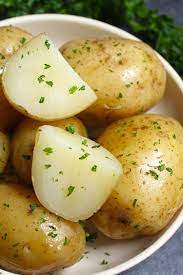Boiling potatoes is a fundamental cooking technique used to prepare a wide range of dishes, from mashed potatoes to potato salads and stews. Achieving the perfect boiled potato requires an understanding of various factors that influence cooking time, texture, and flavor. In this comprehensive guide, we will delve into the intricacies of boiling potatoes, exploring different types of potatoes, preparation methods, cooking times, and tips for achieving optimal results.
Table of Contents
Understanding Potatoes and Their Varieties
Potato Types:
- Starchy Potatoes: Varieties such as Russet or Idaho potatoes have a high starch content and are ideal for making fluffy mashed potatoes or crispy roasted potatoes.
- Waxy Potatoes: Varieties like Yukon Gold or Red potatoes have a lower starch content and hold their shape well when boiled, making them perfect for potato salads or soups.
Preparation Methods:
- Peeling: While peeling potatoes is optional, it can improve the appearance and texture of certain dishes. Peeling also removes any dirt or debris from the potato skin.
- Cutting: Potatoes can be boiled whole, halved, or cut into smaller pieces depending on the intended use. Smaller pieces cook more quickly and evenly than larger ones.
Factors Affecting Cooking Time
Potato Size and Cut:
- Whole Potatoes: Large whole potatoes will take longer to cook compared to smaller ones. It’s essential to ensure uniform size and thickness for even cooking.
- Cut Potatoes: Smaller potato pieces will cook faster than larger ones due to increased surface area exposed to heat.
Potatoes’ Starch Content:
- Starchy Potatoes: High-starch potatoes tend to break down more easily when boiled, resulting in a softer texture. They may require less cooking time than waxy potatoes.
- Waxy Potatoes: Low-starch potatoes retain their shape better when boiled and may require slightly longer cooking times to achieve desired tenderness.
Water Temperature and Salt:
- Boiling Water: Starting with cold water and bringing it to a boil gradually can help potatoes cook more evenly and prevent them from falling apart. Adding salt to the water can enhance the flavor of the potatoes.
Step-by-Step Guide to Boiling Potatoes
Step 1: Preparation
- Choose Potatoes: Select the appropriate type of potato based on your recipe and preferences.
- Peel (Optional): Peel the potatoes if desired, then rinse them under cold water to remove any excess dirt or debris.
- Cut (Optional): Cut the potatoes into uniform pieces to ensure even cooking.
Step 2: Boiling
- Boil Water: Fill a pot with enough cold water to cover the potatoes. Add salt to the water if desired and bring it to a boil over medium-high heat.
- Add Potatoes: Carefully add the prepared potatoes to the boiling water. Ensure they are submerged evenly.
- Cook Potatoes: Boil the potatoes until they are tender when pierced with a fork or knife. Cooking times will vary depending on the size and type of potatoes:
- Small whole potatoes: 15-20 minutes
- Large whole potatoes: 25-30 minutes
- Cubed or halved potatoes: 10-15 minutes
Step 3: Testing for Doneness
- Check Texture: Test the potatoes for doneness by piercing them with a fork or knife. They should be tender but not mushy.
- Drain Potatoes: Once cooked, carefully drain the potatoes in a colander to remove excess water.
Tips for Perfectly Boiled Potatoes
- Use the Right Potatoes: Choose the appropriate type of potatoes based on your recipe and desired texture.
- Uniform Size: Cut potatoes into uniform pieces to ensure even cooking and prevent some pieces from becoming overcooked while others are still undercooked.
- Start with Cold Water: Place potatoes in cold water and bring it to a boil gradually to ensure even cooking and prevent the exterior from overcooking before the interior is done.
- Avoid Overcooking: Be mindful of cooking times and test the potatoes for doneness regularly to avoid overcooking, which can result in mushy potatoes.
- Seasoning: Consider adding herbs, spices, or aromatics to the boiling water to infuse the potatoes with additional flavor.
Boiling potatoes is a fundamental cooking technique that yields versatile and delicious results when done correctly. By understanding the factors that influence cooking time, choosing the right type of potatoes, and following proper preparation and cooking methods, you can achieve perfectly boiled potatoes for a variety of dishes. Whether you’re making mashed potatoes, potato salad, or a hearty stew, mastering the art of boiling potatoes will elevate your culinary creations and delight your taste buds. So, roll up your sleeves, grab your potatoes, and embark on a delicious cooking adventure!
SF
